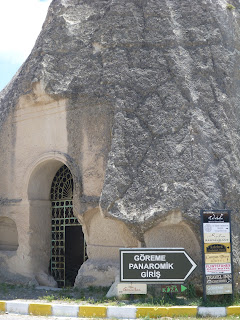Today we leave for Rhodes. This morning we went to the Archeological Museum and the new Sculpture Museum. These were knock-outs, not least because yesterday and the day before we visited Knossos and Phaestos, from which many of the museum objects originally came.
This
is temporary posting that I will update as I have time. I wanted to
get these pictures and minimal commentary down while I can still
remember what we found so astonishing.
The top photo is of the entire "dolphin fresco" found in the "Queen's Quarters" in the Knossos Palace. If you look closely, you will see the variations in color that I have enlarged in the next two photos. The smooth areas are "reproductions" (painted in later on in order to "complete" the piece); the darker areas with lots of whitish cracks running through them are actual pieces of the fresco found during the archeological excavation. Many of these pieces may have been found still adhered to the wall in their correct relation to one another, but others were no doubt found in several pieces dispersed over a wider area. They had to be painstakingly reconstructed into the composite seen in the first photo. It was easier to see when looking at this in the museum that only about 10 percent of the original still exists. In other words, to "reconstruct" this is not just a matter of putting a puzzle together. It's more like putting a puzzle together when you have only 50 pieces of a 500 piece puzzle!!!
[How difficult and uncertain that can be was demonstrated by another fresco that I didn't photograph. The museum showed two versions--the original assumed that the body of the "saffron gatherer" was that of a young boy. A later find on a similar subject revealed a monkey's face, rather than a boy's. What had been identified as a vine in the first version turned out to be the tail of a different monkey in the second--and it was also place in a slightly different position. So it isn't enough to be an archeologist, one must also solve mysteries and have a great aesthetic sense!]
These are evidence of the superb skills of Minoan artists who worked in gold. Ken read somewhere that modern artists have been unable to match this ancient level of craftsmanship. The gold beads in the top photo are no more than 1/2 inch long. The one on the left is either a frog or a lion (we can't remember which); the right is simply called a "cylinder."
The bottom figure is no more than 1 1/2 inches wide--in other words, less than 1/4 the size you see pictured here. It is called the "Gold Bee Pendant." The museum description says: "Two bees are placing a drop of honey in a honeycomb they hold between their legs; on their heads is a wire cage with a gold globule inside." The figure contains three different kinds of gold-work: filigree, repousse, and granulated decoration. I have no idea what all that means, but imagine doing that incredibly fine work on such a tiny space! As you can see, on the left-most dropped circle, a couple of the gold balls around the perimeter are missing. Each of those balls is about the size of a pencil point!! Similarly with the "honeycomb" in the middle.
I was bowled over by the decorations on these pieces, made about 1600 B.C. The vase on the right of the upper photo is called the "Lily Vase"--as you can see, flowers are attached at the sides and near the bottom. The vase is about 18" high. Both vases in that photo have a a lot of red in the glaze. The three vases in the lower photo have incredibly delicate designs that somehow also seem very modern. The central vase or beaker is about 14" high and the others are about 9" high.
The gold oval on the right no more than 3/4" wide. The larger oval in the same photo is a sketch of the picture engraved on the oval. It appears to be a cross-section of part of the Knossos Palace (the three level building). The woman sketched on the right (not in the same scale as the building) is a fertility/nature goddess, usually pictured with a snake wound around her or--in this case--in her hands. She is standing on what appears to be a ramp between a series of steps and the building. This was probably used as a seal and pressed into clay of official "documents."
Another seal, this time carved into a precious stone (the sketch of the engraving is below it). A woman (probably a similar goddess to the one above) is between two winged gryphons. This is no more than 1 1/2" wide.
This last seal is also about 1/2" wide. The incredibly detailed scene depicts people, animals, fruits, trees, etc.






















































